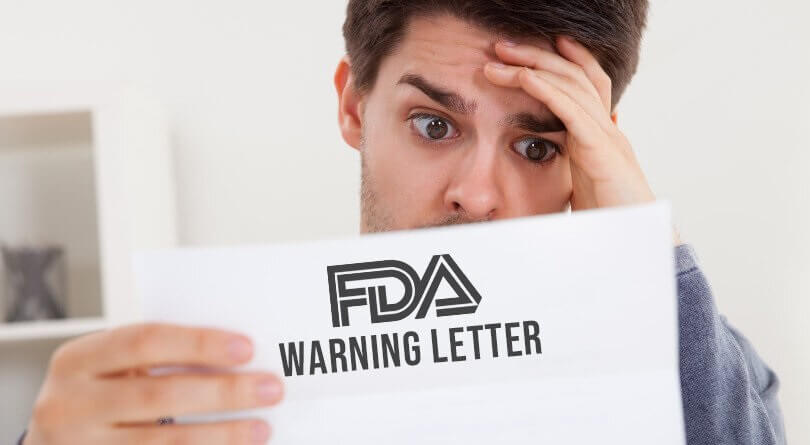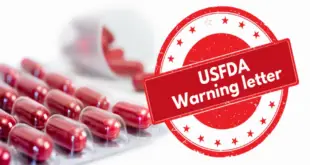FDA Pharma FDA Warning Letter September 14, 2023
The United States Food and Drug Administration (FDA) inspected your firm, Fenwal International, Inc. (a Fresenius Kabi company), located at Road 357, Km 0.8, Maricao, PR 00606, between September 12, 2022 and September 24, 2022. During the inspection, the FDA investigators documented significant deviations from current good manufacturing practice (CGMP) requirements in the manufacture of your blood-pack units (BPUs) with and without in-line leukoreduction filters, as well as Alyx component solutions, Amicus component solutions, and InterSol, a platelet additive solution (collectively, “your products” or “your terminally sterilized products”).
These deviations from CGMP requirements include failure to conform to applicable requirements of Section 501(a)(2)(B) of the Federal Food, Drug, and Cosmetic Act (FD&C Act) [21 U.S.C. § 351(a)(2)(B)] and Title 21, Code of Federal Regulations (21 CFR), Parts 210 and 211.
At the close of the inspection, FDA issued and discussed with your firm a Form FDA-483, List of Inspectional Observations, which described significant deviations from CGMP requirements noted during the inspection. FDA identified additional significant deviations upon further review of the information collected during the September 2022 inspection, as discussed below. The CGMP deviations include, but are not limited to, the following:
1. Failure to follow established, approved written procedures and thoroughly investigate any unexplained discrepancy or the failure of a batch or any of its components to meet any of its specifications, whether or not the batch has already been distributed [21 CFR 211.192]. Specifically:
a. During the annual product review periods ranging from January 01, 2021 to February 28, 2022, approximately 28 batches/lots of your terminally sterilized products exceeded your firm’s action limit for bioburden samples taken from bulk solutions (i.e., “mixing tanks”) or “finished unsterilized units.” Results for approximately 21 lots were considered too numerous to count (TNTC). Additionally, approximately 31 lots of finished unsterilized units exceeded the spore count action limit. At the time of the inspection, your investigations into these excursions were not thorough because the investigations did not include an evaluation to determine the root cause, although batches had been released.
b. Your firm does not investigate “swarming organisms” as a TNTC result, as required by your established, written Procedure for Plate Counting of Microbiological Samples applicable to bioburden testing, water testing, and environmental monitoring among other tests.
Your firm’s failure to conduct adequate failure investigations is a repeat deficiency noted during our 2010, 2012, 2013 and 2021 inspections.

2. Failure to test in-process materials for identity, strength, quality, and purity, as appropriate, and approve or reject by the quality control unit, during the production process [21 CFR 211.110(c)]. For example, your firm failed to reject lots of your bulk solutions (i.e., “mixing tanks”) and finished unsterilized units with in-process bioburden results of TNTC.
3. Failure to establish and follow appropriate written procedures designed to prevent microbiological contamination of drug products purporting to be sterile, including procedures for validation of all aseptic and sterilization processes [21 CFR 211.113(b)]. For example:
a. Your firm has failed to establish that your sterilization process can achieve your established minimum sterility assurance level (SAL) of (b)(4) when TNTC bioburden levels are present in your finished unsterilized units.
b. Your firm has failed to establish and follow appropriate written procedures to prevent microbiological contamination of finished units of your products prior to terminal sterilization. Bioburden control is critical for preventing a challenge to your validated sterilization process and to minimize bioburden-associated byproducts.
4. Failure to clean, maintain, and, as appropriate for the nature of the drug, sanitize and/or sterilize equipment and utensils at appropriate intervals to prevent contamination that would alter the safety, identity, strength, quality, or purity of the drug product beyond the official or other established requirements [21 CFR 211.67(a)]. For example:
a. Inspection of filling module (b)(4) on September 13, 2022, revealed an approximate two-inch hole on top of the HEPA box, broken edges and residue on the diffusion grate above the filling nozzles, tubing ports with missing tubing connections, and brown residue on filling equipment surfaces near the filling nozzle. This filling area is used to manufacture Amicus component solutions, Alyx component solutions, and Intersol.
b. Inspection of mixing room (b)(4) on September 22, 2022, revealed apparent black growth on room-supply HEPA filters and black residue inside mixing tank (b)(4)2.
5. Failure to maintain buildings used in the manufacture, processing, packing, or holding of drug products in a good state of repair [21 CFR 211.58]. For example, FDA’s inspection of mixing room (b)(4) revealed gaps in the ceiling that connect to the unclassified utility space, cracked and peeling surfaces on the floors and walls, flaking paint on the ceiling near air return vents, and a tarp collecting pooling water in the ceiling space approximately fifty feet from filling room (b)(4). It is essential that your facility is in a good state of repair to protect drug products from potential routes of contamination.
6. Failure to establish laboratory controls that include scientifically sound and appropriate specifications, standards, and test procedures designed to assure that components, in-process material, and drug products conform to appropriate standards of identity, strength, quality, and purity [21 CFR 211.160(b)]. For example:
a. Your approach to calculating the SAL for lots of finished unsterilized units of your products with TNTC pre-sterilization bioburden results is not scientifically sound. Your firm calculated the SAL using a value of (b)(4) when the results obtained were TNTC. As noted by your firm during the inspection, TNTC is not a number and cannot be used to calculate the SAL. Your firm has used this erroneous calculation to determine the impact of TNTC results on the sterility assurance of the involved lots.
b. You did not conduct a study to demonstrate the suitability of your bioburden test method for Anticoagulant Citrate Dextrose Solution, USP, Formula A (ACD-A) that demonstrates your ability to detect a variety of organisms in the presence of ACD-A. Your bacteriostatic study, performed in 1988, only included Bacillus subtilis and Candida Albicans as test organisms. ACD-A is one of your Alyx and Amicus component solutions.
c. During the inspection, our investigator observed microbial growth over the majority of the test plate and around the perimeter with no defined edges for bioburden tank sample 71643 for Citrate Phosphate Dextrose (CPD) bulk solution. Your Quality Manager stated that the observed plate growth would only be documented as 1 CFU. CPD is part of your BPU product.
We acknowledge receipt of your letters dated October 17, 2022, November 14, 2022, December 16, 2022, January 19, 2023, February 14, 2023, March 17, 2023, April 17, 2023, May 12, 2023, and July 25, 2023, which respond to the Form FDA-483 and set forth your corrective actions. We have reviewed your represented corrective actions. For some of your corrective actions, you have not provided sufficient detail to assess their adequacy. For example, your firm has not provided sufficient evidence that corrective actions to reduce bioburden in mixing tanks and filled units are effective. More notably, your commitments do not adequately resolve your recurring violations, including your firm’s failure to conduct adequate failure investigations.
Your firm, including your quality unit, continuously has failed to adequately correct your violations and—for those violations that FDA has observed during previous inspections—prevent their recurrence. Indeed, the nature of your violations demonstrates that your quality control unit has failed to ensure that your firm manufactures drug products that meet established specifications for identity, strength, quality, and purity.
Additionally, the CGMP deviations cited in this letter pose a significant risk that the products may be contaminated with microorganisms. We note that organisms previously recovered in your facility and bioburden samples of your products were genetically matched to isolates from clinical cases of septic reactions involving Acinetobacter species and Staphylococcus saprophyticus3. In addition, an instance of TNTC in bioburden testing occurred in Amicus lot (b)(4), which was used to collect platelets implicated in a septic transfusion reaction. More recently, according to your April 2023 response, Acinetobacter baumanni was recovered from a tank used for Amicus lot (b)(4) on March 24, 2023, and an environmental monitoring sample on November 01, 2022.
Neither this letter nor the observations noted on the Form FDA-483, which were discussed with you at the conclusion of the inspection, are intended to be an all-inclusive list of deficiencies that may be associated with your products. It is your responsibility to ensure that your establishment fully complies with the FD&C Act, the Public Health Service Act (PHS Act), and all applicable regulations. You should take prompt action to correct these violations.
This letter notifies you of our findings and provides you an opportunity to address them.
Failure to adequately correct these matters may lead to regulatory action without further notice. Such actions include seizure and/or injunction.
We request that you respond in writing within fifteen (15) working days from your receipt of this letter, outlining the specific steps you have taken or plan to take to address any violations and prevent their recurrence. Include any documentation necessary to show that the matters have been addressed. If you do not believe your products are in violation of the FD&C Act, PHS Act, or applicable regulations, include your reasoning and any supporting information for our consideration. If you cannot address these matters completely within fifteen (15) working days, please explain the reason for your delay and the timeframe for completion.



